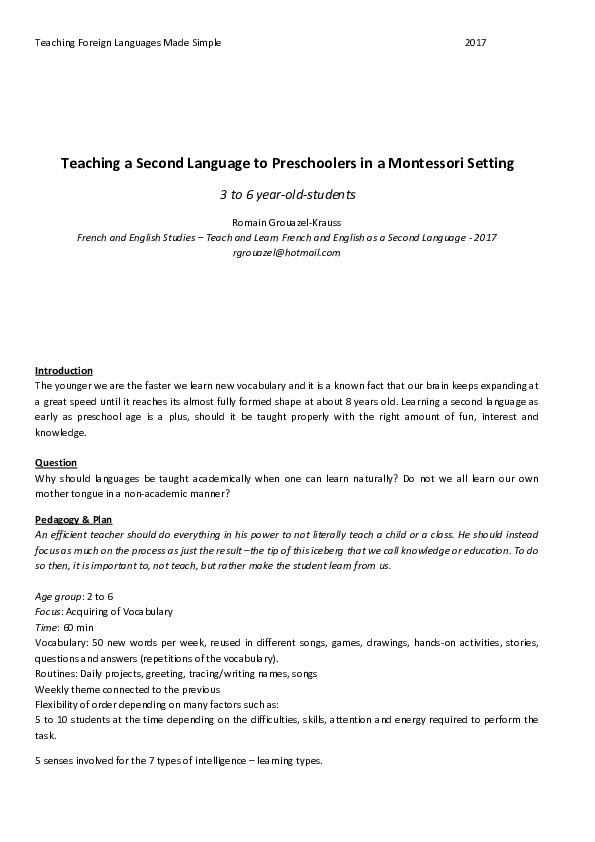Academia.edu no longer supports Internet Explorer.
To browse Academia.edu and the wider internet faster and more securely, please take a few seconds to upgrade your browser.
Teaching a Second Language to Preschoolers in a Montessori Setting 3 to 6 year-old-students
Teaching a Second Language to Preschoolers in a Montessori Setting 3 to 6 year-old-students
Introduction The younger we are the faster we learn new vocabulary and it is a known fact that our brain keeps expanding at a great speed until it reaches its almost fully formed shape at about 8 years old. Learning a second language as early as preschool age is a plus, should it be taught properly with the right amount of fun, interest and knowledge.
Related Papers
Learners' learning style preference is one of the vital issues in the EFL (English as a Foreign Language) arena. Different learners learn English differently. But there must be a close proximity between the teachers'preferred teaching style and the learners' favored learning style. The present study was done on 145 senior cadets of Sylhet Cadet College. The situation of English in cadets is no doubt good. But there are still some teaching systems that must be reconsidered and therefore renovated teaching styles based on cadets' style preference should be introduced. To conduct the survey a questionnaire was followed. The findings show that various cadets belong to various categories of learning style. A brief analysis of the findings is presented. Besides, this paper offers some suggestions for the teachers based on the findings of the survey.
The main aim of this study is specifically designed to find out how to develop game materials and hopefully come out with results providing insight to the question " How can we easily memorize vocabulary items and how can we promote effective ways to learn English vocabulary in a relaxed manner. The findings suggest that the use of games in foreign language learning may benefit the process in many aspects such as memory of vocabulary. The results proved that the occurrence of memorize is improved with games, and therefore may be a more efficient way to encourage language acquisition.
2013 •
Brain-based learning is finding its way into more and more classrooms. Bright peripherals and hands-on manipulatives can be found in most American schools. As more schools develop brain-compatible learning environments, the quality of student learning will improve.
Advenced Diploma in Education and Professional Development UEA Norwich (UK)
Master thesis “Creative activities as educational treatment of intellectual development of 4-6 years old children in foreign language as interest education classes” gives an insight of child’s cognitive development stages, intellectual growth and diversity, as well as states the basic meaning of interest education and the importance of foreign language teaching in preschool. All these aspects are discussed in the context of creativity. A research has been made in order to analyse the importance of creativity and its impact on intellectual development in preschool. As key theories were used Gardner’s multiple intelligences, Piaget child development stages, Bloom’s taxonomy, Saussure’s linguistic model, Vygotsky’s theory of play in childhood, Montessori’s approach. The main conclusion is that creative approach not only enriches child’s experience, diversifies teaching method, but also is a benefit for child’s intellectual development. Key words: Education, preschool, creativity, intellectual development, interest education, foreign language, experience, diversity.
RELATED PAPERS
Studia Semitica
Falling Trees and Forking Tongues: The Place of Akkadian and Eblaite within Semitic (Fs. Militarev, Moscow, 2003)2003 •
Sociology of Race and Ethnicity
Response to Weddington: More Lessons from Afro-Pessimism2019 •
Forpoczta Hitlera. Niemiecka dywersja w Polsce w 1939 roku
Forpoczta Hitlera. Niemiecka dywersja w Polsce w 1939 roku2010 •
Desacatos. Revista de Ciencias Sociales
Tabú.Sexo, identidad y subjetividad erótica en la antropología2014 •
The Role of Reflective Journals
ARTICLE TITLE: THE ROLE OF REFLECTIVE JOURNALS IN PROFESSIONAL DEVELOPMENT OF TESOL INSTRUCTORS: A REVIEW2024 •
2005 •
2017 •
Call Girls Hydrabad
▶ ●─Cash On Delivery Call Girls In ( East Marredpally )꧁❤⎝ 7023059433 ⎠❤꧂2011 •
African Journal of Traditional, Complementary and Alternative Medicines
Evaluation of Neolamarckia cadamba (Roxb.) bosser leaf extract on glucose tolerance in glucose-induced hyperglycemic mice2010 •
Journal of the American Chemical Society
Nucleation and Growth Mechanism of Lithium Metal Electroplating2019 •

 Romain Grouazel-Krauss
Romain Grouazel-Krauss